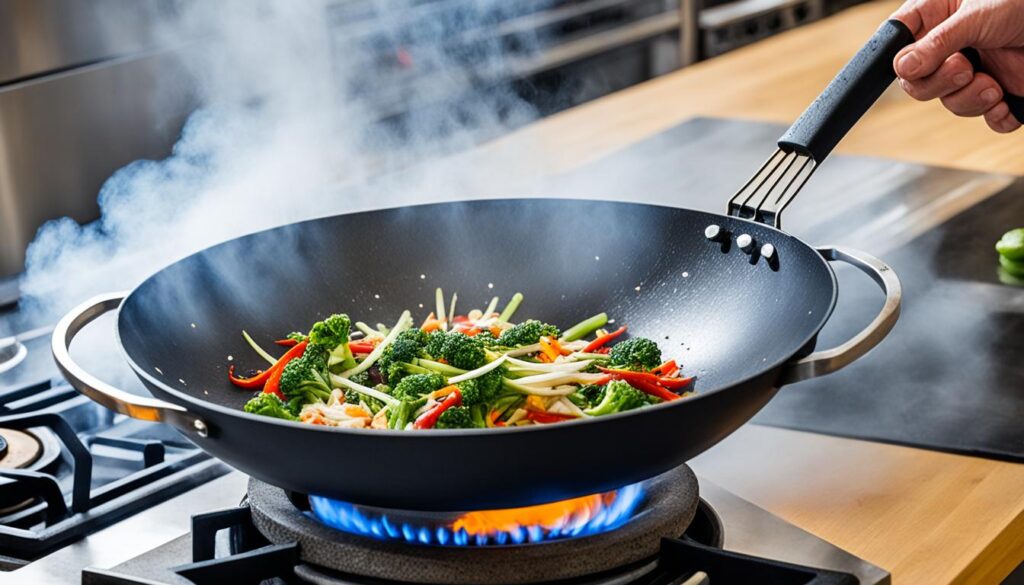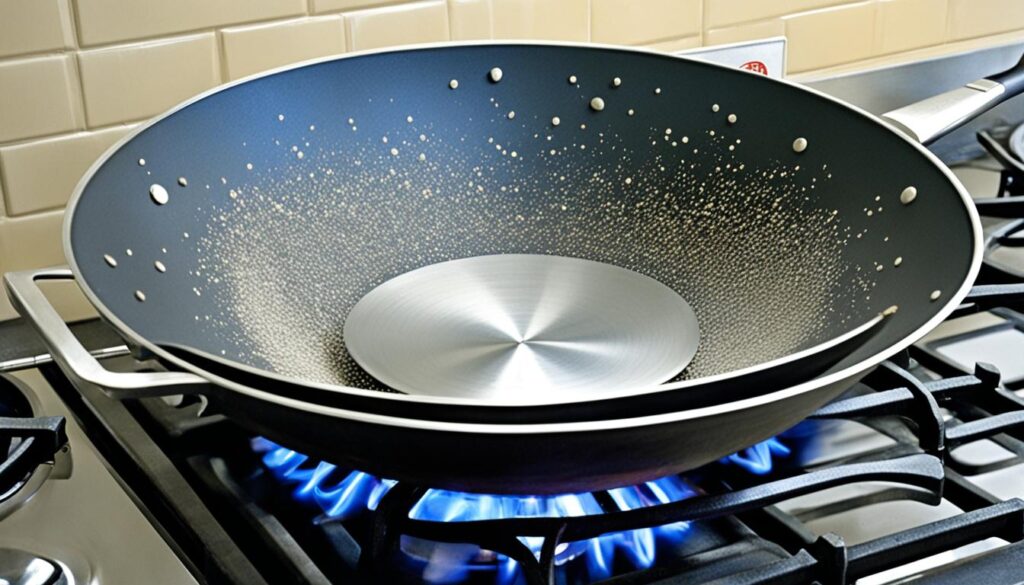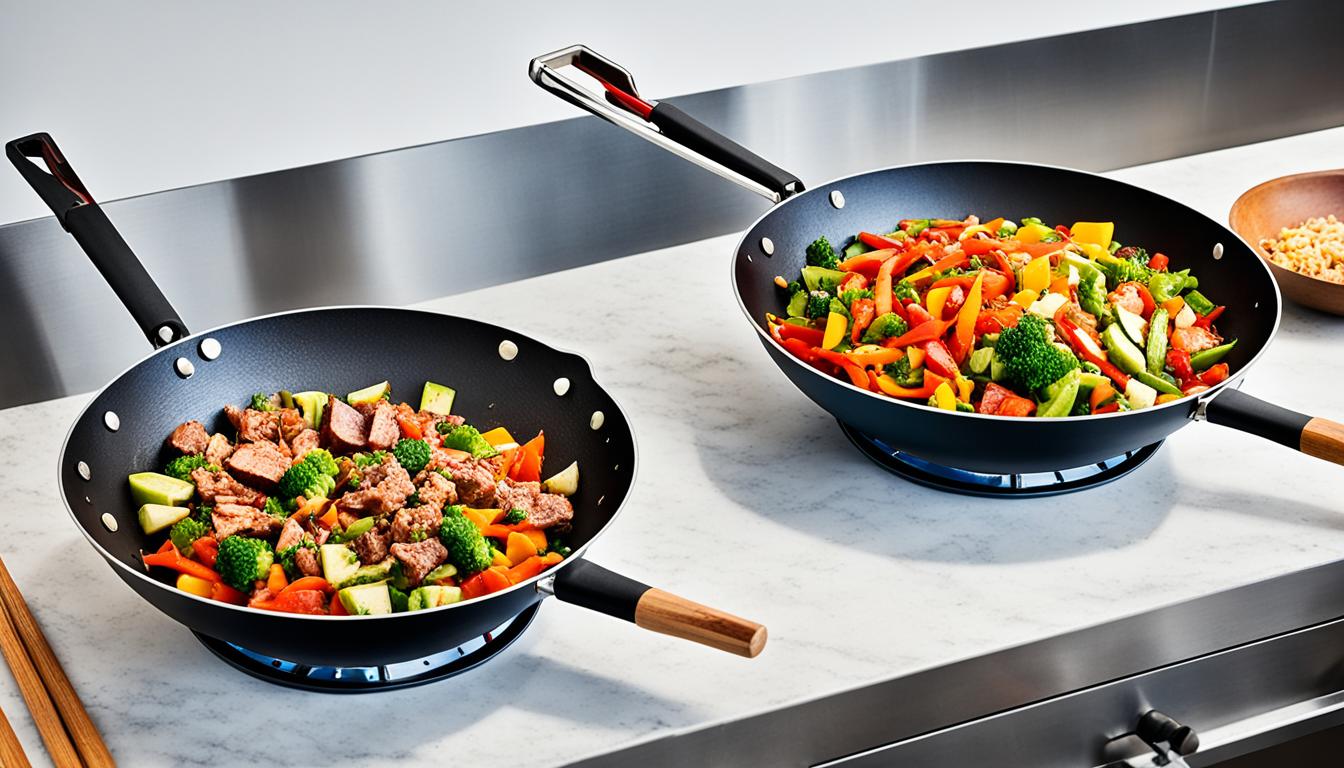When it comes to woks, the shape of the cooking surface can make all the difference in your culinary adventures. Have you ever wondered why some woks have a flat bottom while others are round? Does the shape really affect the taste and cooking experience? Let’s dive into the world of wok shapes and uncover the best pick for you.
Key Takeaways:
- Flat-bottomed woks are versatile and compatible with various types of stoves, providing a stable cooking surface.
- Round-bottomed woks are ideal for wok burners and offer even heat distribution, allowing for the traditional tossing motion.
- Consider your stove type, desired cooking techniques, and stability requirements when choosing the best wok shape for your needs.
- Flat-bottomed woks heat up faster and have more surface area for food, while round-bottomed woks offer better heat distribution and scooping capabilities.
- The choice between flat and round bottomed woks ultimately depends on personal preference and desired cooking experience.
Choosing the Right Shape of Wok
When it comes to selecting the perfect wok, one of the key considerations is the shape of the base. The decision between a flat-bottomed and round-bottomed wok depends on various factors that can greatly impact your cooking experience. Let’s explore the factors to consider when choosing the right shape of wok.
1. Heat Source Compatibility
When deciding between a flat-bottomed and round-bottomed wok, it’s essential to consider the type of stove or cooktop you have. If you own a flat cooktop, such as gas, electric coil, ceramic, or induction, a flat-bottomed wok is the most suitable choice. A flat-bottomed wok provides a stable cooking surface and efficiently heats up, allowing for excellent heat distribution and consistent cooking results.
2. Cooking Techniques
If you prefer to cook using traditional Chinese stir-frying techniques or enjoy the art of the circular tossing motion, a round-bottomed wok is recommended. The round shape of the wok facilitates even heat distribution, ensuring your ingredients are cooked uniformly. The curved design also makes it easier to scoop and scrape food.
3. Stability
Consider the stability of the wok on your stove or cooktop. Flat-bottomed woks typically provide a more secure and stable cooking surface, making them suitable for a wide range of stove types. On the other hand, round-bottomed woks require additional accessories, such as a wok ring or the WokMon, to provide stability on gas ranges.
4. Desired Cooking Experience
Think about the cooking experience you’re looking for. If versatility and ease of use are your priorities, a flat-bottomed wok is an excellent choice. It allows for easy tossing and flipping of food and offers a larger surface area for cooking. Alternatively, if you’re seeking an authentic wok experience with restaurant-quality results, a round-bottomed wok is the way to go.
Consider these factors, such as heat source compatibility, desired cooking techniques, and stability requirements, when choosing the right shape of wok for your culinary adventures. Remember that the best wok shape is the one that aligns with your cooking preferences and kitchen setup.
Advantages of Flat-Bottomed Woks
When it comes to cooking with woks, flat-bottomed woks offer a range of advantages that make them a popular choice for many home cooks. Let’s explore some of the key benefits and features of flat-bottomed woks:
- Compatibility with Different Heat Sources: One of the biggest advantages of flat-bottomed woks is their compatibility with various heating elements. Whether you have a gas, electric, or induction stove, a flat-bottomed wok can be used effortlessly.
- Stable Cooking Surface: Flat-bottomed woks provide a stable surface for cooking, ensuring that your food stays in place and reducing the risk of accidental spills. This stability is especially beneficial for novice cooks.
- Efficient Heat Distribution: Flat-bottomed woks heat up faster and more efficiently compared to their round-bottomed counterparts. This means that you can start cooking in no time and enjoy evenly cooked dishes.
- Ample Cooking Space: With slightly more surface area at the bottom, flat-bottomed woks allow for larger food capacity. This feature is particularly advantageous when cooking for a family or preparing meals in bulk.
- High-Quality Materials: Most flat-bottomed woks are made of carbon steel or cast iron, which are known for their durability and excellent heat retention. These materials ensure that your wok can withstand high temperatures and provide consistent results.
“Flat-bottomed woks offer compatibility, stability, efficient heat distribution, ample cooking space, and high-quality materials, making them a reliable and versatile choice for everyday cooking.”
To give you a clearer picture, here’s a table comparing the advantages of flat-bottomed woks:
| Advantage | Description |
|---|---|
| Compatibility with different heat sources | Flat-bottomed woks can be used on gas, electric, and induction stoves. |
| Stable cooking surface | Provides a stable surface for safe and easy cooking. |
| Efficient heat distribution | Heats up faster and ensures even cooking. |
| Ample cooking space | Allows for larger food capacity. |
| High-quality materials | Most flat-bottomed woks are made of carbon steel or cast iron. |
As you can see, flat-bottomed woks offer a range of advantages that make them a reliable and convenient choice for everyday cooking.
Drawbacks of Flat-Bottomed Woks
While flat-bottomed woks offer many advantages, they are not without their drawbacks. It’s essential to consider these limitations before making your decision.
1. Burned Foods
When using a flat-bottomed wok on a traditional wok burner, there is a higher risk of burning food at the bottom. The concentrated heat may cause food to stick and scorch, compromising the taste and texture of your dishes.
2. Limited Movement
One of the challenges of cooking with flat-bottomed woks is the restriction in movement. Unlike their round-bottomed counterparts, flat-bottomed woks do not allow for the true circular “flip” motion. This limits your ability to move food through different cooking zones effectively, potentially resulting in unevenly cooked ingredients.
3. Warping
Depending on the material and gauge of the flat-bottomed wok, there is a possibility of warping over time. Warping can affect the flatness of the wok’s bottom, causing uneven heat distribution and reducing its effectiveness on induction surfaces.
Despite these limitations, flat-bottomed woks remain popular among home cooks due to their versatility and compatibility with various stove types. They are a convenient option for everyday cooking and provide a stable cooking surface.

Advantages of Round-Bottomed Woks
Round-bottomed woks provide several unique advantages for those who seek to achieve authentic wok cooking. These woks are specifically designed for wok burners, enabling powerful flames to rise up and over the lip of the wok. This allows for the development of the highly sought-after wok hei flavor, which is characteristic of restaurant-quality Chinese dishes and adds a distinct smoky taste to the food.
One of the key advantages of round-bottomed woks is their ability to distribute heat more evenly compared to flat-bottomed woks. This even heat distribution ensures uniform cooking, preventing hot spots that can lead to unevenly cooked food. Round-bottomed woks also facilitate the essential circular tossing motion that is integral to stir-frying, creating that signature wok stir-fry effect. This motion effectively mixes and evenly coats the ingredients with sauce and spices, enhancing the flavor and texture of the dish.
Another benefit of round-bottomed woks is their curved shape, which makes it easier to scoop and scrape food during the cooking process. The curvature allows for efficient movement and manipulation of the ingredients, ensuring that every morsel is cooked to perfection. Additionally, round-bottomed woks are less prone to warping compared to their flat-bottomed counterparts, providing long-lasting durability and stability during cooking.
One notable advantage of round-bottomed woks is their ability to be used without a flat cooking surface. Unlike flat-bottomed woks that require a stable and flat surface for optimal performance, round-bottomed woks can be used directly over the open flame of a wok burner. This eliminates the need for additional accessories and ensures a seamless cooking experience.
Overall, round-bottomed woks offer a range of advantages for those who value the authentic wok cooking experience. From their ability to create the coveted wok hei flavor to their even heat distribution and ease of use, these woks are a valuable tool for achieving delicious and professional-quality stir-fried dishes.

Drawbacks of Round-Bottomed Woks
Despite the many advantages of round-bottomed woks, they also come with certain limitations and challenges that should be considered before making a purchase decision. Let’s explore the disadvantages of cooking with round-bottomed woks.
1. Incompatibility with Electric, Induction, and Ceramic Cooktops
One of the main drawbacks of round-bottomed woks is that they cannot be used on electric, induction, or ceramic cooktops. These types of heating elements do not provide adequate heat and stability for round-bottomed woks. As a result, if you have one of these cooktops, you will not be able to fully utilize a round-bottomed wok for your cooking needs.
In contrast, flat-bottomed woks offer compatibility with a wide range of stove types, including electric, induction, and ceramic cooktops. This makes flat-bottomed woks a more versatile choice for home cooks who have these types of stoves.
2. Additional Accessories for Stability on Gas Ranges
When using a round-bottomed wok on a gas range, additional accessories are required to provide stability. A wok ring or the WokMon is commonly used to support the round-bottomed wok on the gas burner. These accessories help prevent the wok from tipping over during cooking and ensure a more secure cooking experience.
However, the need for additional accessories can be cumbersome and add to the cost of using a round-bottomed wok on a gas range. This is an important consideration for those who prefer a more straightforward cooking setup without the need for extra equipment.
3. Limited Versatility Compared to Flat-Bottomed Woks
While round-bottomed woks excel in certain cooking techniques, such as stir-frying, they have limited versatility compared to flat-bottomed woks. Round-bottomed woks are specifically designed for the circular tossing motion that is essential in stir-fry cooking. However, they may not be as suitable for other cooking methods or dishes that require a more stable cooking surface.
On the other hand, flat-bottomed woks offer a wider range of cooking possibilities. Their stable cooking surface allows for various cooking techniques, from stir-frying to deep-frying and braising. Flat-bottomed woks provide more versatility in terms of the types of dishes you can prepare.
“While round-bottomed woks are great for stir-frying, their limitations on different stove types and the extra accessories required may make flat-bottomed woks a more practical choice for most home cooks.”
| Round-Bottomed Woks | Flat-Bottomed Woks |
|---|---|
| Not compatible with electric, induction, or ceramic cooktops | Compatible with a wide range of stove types |
| Require additional accessories for stability on gas ranges | Do not require additional accessories for stability |
| Limited versatility for cooking techniques other than stir-frying | Offer versatility for various cooking methods |
In conclusion, round-bottomed woks offer unique advantages for specific cooking techniques but have notable drawbacks that should be considered. The incompatibility with certain types of cooktops, the need for additional accessories on gas ranges, and the limited versatility compared to flat-bottomed woks are important factors to weigh when choosing the right wok for your needs.

Choosing the Best Wok Shape for You
When it comes to selecting the best wok shape for your culinary adventures, there are a few considerations to keep in mind. The choice between a flat-bottomed and round-bottomed wok ultimately depends on your personal preferences, cooking style, and kitchen setup. Let’s explore the factors you should consider before making your decision.
Compatibility and Versatility
If you’re a home cook looking for versatility and compatibility with various heat sources, a flat-bottomed wok is the way to go. Flat-bottomed woks are designed to work seamlessly with gas, electric, ceramic, and induction stoves. This means you can enjoy the benefits of wok cooking no matter what type of stove you have in your kitchen.
Stability and Ease of Use
A flat-bottomed wok provides a stable cooking surface, allowing you to cook with confidence. Whether you’re stir-frying, deep-frying, or braising, a flat-bottomed wok ensures even heat distribution and a secure cooking experience. With its wide and flat base, it offers ample space for tossing and turning your ingredients, making it easy to achieve that perfect stir-fry.
Traditional Techniques and Flavors
On the other hand, if you’re a fan of traditional wok cooking techniques and crave that authentic circular tossing motion, a round-bottomed wok might be more suitable for you. Round-bottomed woks are designed for use with dedicated wok burners, providing intense heat and allowing flavors to develop beautifully. The circular tossing motion and curved profile of a round-bottomed wok also make it easier to scoop and scrape your ingredients, enhancing your cooking experience.
However, it’s important to note that round-bottomed woks are not compatible with electric, ceramic, or induction stoves. They require additional accessories, such as a wok ring or the WokMon, to provide stability on gas ranges. These accessories allow for a more direct gas flame and recreate the high heat used in commercial kitchens.
The Perfect Wok Shape for You
When it comes down to it, choosing the best wok shape is a matter of personal preference. Consider factors such as the type of stove you have, your desired cooking techniques, and stability requirements. If you’re looking for versatility, ease of use, and compatibility, a flat-bottomed wok is likely the best choice. If you’re passionate about traditional techniques and have a dedicated wok burner, a round-bottomed wok might be the perfect fit for you. Ultimately, the best wok shape is the one that suits your cooking style and brings joy to your culinary adventures.
Using Round-Bottomed Woks on Different Stoves
Round-bottomed woks offer a unique cooking experience, but they are not compatible with electric, induction, or ceramic cooktops. However, if you have a gas stove, there are ways to make round-bottomed woks work for you. With the right accessories, you can achieve stability and enhance heat distribution, ensuring successful wok cooking.
Wok Rings: Providing Stability and Support
One option for using a round-bottomed wok on a gas stove is to use a wok ring. A wok ring is a metal stand designed to provide stability and support for the round-bottomed wok. By placing the wok on the wok ring, you create a secure cooking surface that allows you to toss and stir-fry with ease. The wok ring elevates the wok, allowing the flames to reach the sides and bottom of the wok more effectively.
The WokMon: Transforming Your Gas Stove
If you’re looking for a more comprehensive solution, the WokMon is an accessory that can transform your circular gas stove into a dedicated wok range. The WokMon sits on top of your gas burner and focuses the flames directly onto the bottom of the round-bottomed wok. This intense heat replicates the high temperatures found in commercial kitchens and allows for authentic wok cooking. The WokMon enhances heat distribution and ensures even cooking throughout the wok, resulting in delicious stir-fries and other wok-based dishes.
When using round-bottomed woks on different stoves, it’s crucial to ensure compatibility between the wok, the accessory used (such as a wok ring or the WokMon), and the specific stove type. Choosing the right combination will provide stability, enhance heat distribution, and allow you to enjoy the benefits of cooking with a round-bottomed wok.
Stove Compatibility Guide
| Stove Type | Compatible with Round-Bottomed Woks? |
|---|---|
| Gas Stove | Yes – with wok ring or the WokMon |
| Electric Stove | No |
| Induction Stove | No |
| Ceramic Stove | No |
Note: Always refer to the manufacturer’s instructions and safety guidelines when using any accessories with your stove and wok.
Conclusion
After weighing the pros and cons of flat-bottomed and round-bottomed woks, it’s clear that both shapes have their own advantages and limitations. Flat-bottomed woks are versatile and compatible with various heat sources, making them suitable for most home cooks. They provide a stable cooking surface, heat up quickly and efficiently, and offer ease of use. On the other hand, round-bottomed woks are ideal for wok burners and offer even heat distribution. They allow for the traditional circular tossing motion, essential for stir-frying, and make it easier to scoop and scrape food. However, they are limited in terms of stove compatibility and require additional accessories for stability.
In making a decision on the best wok shape, it’s important to consider your own cooking preferences, kitchen setup, and desired cooking techniques. If you prioritize versatility and compatibility, a flat-bottomed wok may be the way to go. It will provide you with a reliable cooking surface and excellent heat distribution. However, if you have a wok burner and want to experience authentic wok cooking, a round-bottomed wok may be the better option for you. Just keep in mind the limitations and required accessories.
So, in conclusion, there is no one-size-fits-all answer when it comes to choosing between a flat-bottomed and round-bottomed wok. It all depends on your individual needs and preferences. Consider the factors discussed in this article, such as heat source compatibility, stability, and desired cooking techniques, to make an informed decision on the perfect wok shape for your culinary needs. Happy wok cooking!
